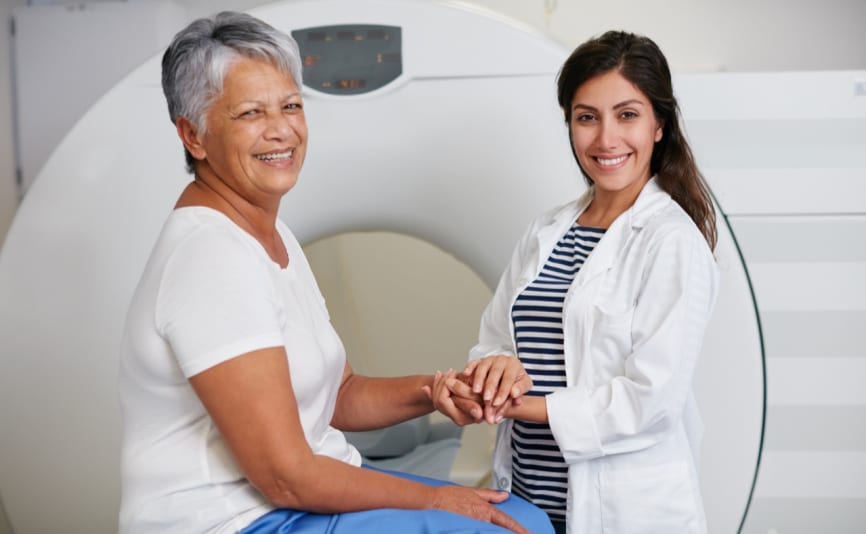Key takeaways:
-
Sacroiliitis is a type of joint inflammation that affects the sacroiliac joints, which connect your spine and pelvis, causing lower back or hip pain.
-
Symptoms can affect one or both sides and often ease with movement.
-
MRI helps detect early inflammation for faster diagnosis and treatment.
-
Causes include injury, arthritis, pregnancy, infection, or certain medications, with the outlook and treatment depending on the specific cause.
If you’re experiencing pain or stiffness in your lower back, hips, legs or buttocks, you may be worried about sacroiliitis. Sacroiliitis is a painful inflammatory condition that can be a symptom of an underlying problem. Magnetic resonance imaging (MRI) can be hugely helpful in getting an early diagnosis and treatment, which can help you manage your symptoms effectively, improving your range of movement and your quality of life. Here’s what you need to know.
What is Sacroiliitis?
Sacroiliitis happens when the sacroiliac joints, which connect your spine to your pelvis, become inflamed, causing pain and stiffness in your lower back, buttocks, or hips. Sacroiliitis is often associated with a group of inflammatory conditions known as spondyloarthritis, which primarily affects the spine and other parts of the skeleton.
The condition can develop gradually or appear suddenly, and your symptoms may come and go, sometimes getting worse after rest or certain activities. It can affect one side of the pelvis or both.
What Are the Main Symptoms of Sacroiliitis?
The main symptom of sacroiliitis is ongoing (chronic) lower back pain and stiffness in the joints, buttocks or hips. It’s often worse in the morning and may ease as you move around during the day. You may also find that you experience a flare-up of symptoms that come and go.
Sacroiliitis can affect one side of your pelvis (unilateral) or both sides (bilateral). Pain on one side can be caused by infection, spondyloarthritis, or physical stress. Inflammatory sacroiliitis usually affects both sides. Your radiologist may also look for swelling in the iliopsoas, a deep muscle in your lower back and pelvis that helps you lift your knees and bend at the hip.
In children and teenagers, sacroiliitis can show slightly different symptoms, including back or neck pain, arthritis in one or several joints, heel pain, and inflammation where tendons attach to bones (enthesitis).
The pain of sacroiliitis often eases once you start moving around. But certain activities and positions can make it worse, such as:
-
sitting or lying in the same position for too long
-
standing for long periods
-
putting more weight on one leg than the other
-
climbing stairs
-
running
-
taking long strides when walking
Can an MRI Scan Detect Sacroiliitis?
Yes, experts say magnetic resonance imaging (MRI) is the gold standard imaging for diagnosing sacroiliitis. Unlike X-rays, CT scans, or ultrasound, MRI can pick up very early signs of the condition. This includes active inflammation, such as bone marrow swelling (oedema), as well as longer-term changes like:
-
Erosions - where the surface of the bone has been worn away or damaged by inflammation
-
Sclerosis - where the bone around the joint has become denser and harder than normal
-
Ankylosis - where the joints fuse.
MRI is also useful when only one sacroiliac joint is affected, which can make diagnosis more difficult. Your radiologist uses MRI to look for extra signs of the condition, such as fluid or swelling in the iliopsoas muscle, to help them differentiate infectious sacroiliitis from other causes.
In children and teens, MRI can be particularly important. For example, in young people with Familial Mediterranean Fever (FMF), a rare inherited condition that causes episodes of painful inflammation, MRI can show advanced sacroiliitis affecting one or both joints, a key characteristic of the condition.
What Does Sacroiliitis Look Like on an MRI?
MRI images can show changes to the joints caused by sacroiliitis, which can help your doctor diagnose the condition. Here’s what those changes might look like on your MRI results:
-
Bone marrow inflammation (oedema): This is often the earliest sign of sacroiliitis on MRI and may show up before any changes are visible on X-ray. It appears as bright areas inside the bone.
-
Inflammation in the lining of the joint or the joint capsule (synovitis and capsulitis): If you have a contrast dye injected before your MRI, it can help to show up a thickening in the joints that signifies inflammation.
-
Inflammation where the tendons and ligaments attach to the bone (enthesitis): These areas may also look thicker and brighter if you have contrast dye.
-
Hardening of the bone (sclerosis): This appears as darker, denser patches around the joint, indicating that the bone has reacted to long-term inflammation.
-
Areas of bone loss (erosions): These show up as irregular gaps or defects along the edge of the joint. If active, they may also appear bright on certain MRI scans.
-
Backfill and fat deposits: Sometimes the body attempts to repair damaged bone by filling in erosions with fat or scar-like tissue, which appears as brighter signals in these areas.
-
Fusion of the joint (ankylosis): In more advanced cases, the sacroiliac joint space may disappear completely, indicating that the bones have fused.
How Does an MRI Scan Detect Sacroiliitis?
An MRI scan uses strong magnets and radio waves to create detailed images of the inside of your body, including bones, joints, and soft tissues. Unlike X-rays or CT scans, MRI doesn’t rely on radiation, making it particularly good at picking up early signs of inflammation and later, structural changes.
MRI is also useful for distinguishing sacroiliitis from other causes of back pain, such as disc problems or muscle injuries, because it can show the exact location and type of inflammation or damage.
How Will My Doctor Diagnose Sacroiliitis?
When checking for sacroiliitis, your doctor will start by asking about your medical history. They’ll want to know how long your back pain has lasted, whether it worsens at rest, and if you notice stiffness in the mornings. They may also ask about other conditions, such as FMF.
Next, they’ll explore your symptoms in more detail, asking about pain in your hips or buttocks and whether movement eases it. During a physical examination, they’ll press and move your sacroiliac joints to check for tenderness, swelling, or limited movement.
They’ll usually order blood tests to look for signs of inflammation, such as CRP and ESR, and may also test for HLA-B27, a genetic marker associated with certain types of arthritis. Doctors often begin with X-rays of the sacroiliac joints, which can reveal changes such as erosions or sclerosis; however, early sacroiliitis may not be visible on these images.
If X-rays don’t give enough information, your doctor will recommend an MRI scan. MRI highlights both active inflammation (bone marrow oedema) and structural changes in the joint. Sometimes, they’ll use a CT scan to examine the bones in more detail.
If your doctor remains unsure, a diagnostic sacroiliac joint injection can help pinpoint the source of the problem. A small amount of local anaesthetic (and sometimes a steroid) is carefully injected directly into the joint under imaging guidance, typically X-ray or CT, to ensure the needle is in the correct position.
If the injection relieves your pain, even if only temporarily, it’s a strong indication that the sacroiliac joint is the source of the discomfort.
If they suspect sacroiliitis, your doctor will refer you to a rheumatologist for specialist care.
Finally, your doctor or medical team will monitor your symptoms, tracking any changes and adjusting your treatment as needed. Sacroiliitis can appear before, after, or alongside other conditions like FMF, so regular follow-up helps manage it more effectively.
What Else Could My Symptoms Be Caused By? (Differential Diagnosis)
Several conditions can cause symptoms that mimic sacroiliitis, so your doctor will consider a range of other causes:
-
Types of inflammatory arthritis include ankylosing spondylitis, psoriatic arthritis, reactive arthritis, or arthritis linked to bowel disease.
-
Infections, including bacterial, viral, or fungal infections, in the joint.
-
Problems linked to wear and tear, such as stress injuries, extra small joints, or fractures in the sacrum.
-
Other factors that can confuse scans include certain types of cancer, hormone imbalances such as hyperparathyroidism, or regular changes in growing bones.
What Are the Causes of Sacroiliitis?
Sacroiliac joint problems can happen for several reasons. A fall, car accident, or other sudden impact can damage the joints and cause pain.
Arthritis is another common cause – both wear-and-tear arthritis (osteoarthritis) and inflammatory types, like ankylosing spondylitis, can affect these joints.
Pregnancy also puts extra strain on the sacroiliac joints, as they loosen to prepare for childbirth, and the added weight and changes in how you walk can make them sore.
In rare cases, the joint can become infected, leading to inflammation and discomfort.
What’s My Prognosis and Treatment for Sacroiliitis?
Sacroiliitis can really affect your daily life, making it harder or more uncomfortable to move, work, or sleep. That’s why an early diagnosis and prompt treatment are so important.
How your condition progresses will often depend on what caused it. For example, people with spondyloarthritis might experience more long-term challenges, especially if their hips or spine are affected.
Infections in the sacroiliac joint can also be serious if not treated promptly, sometimes leading to abscesses or joint damage.
But the good news is that an early diagnosis and treatment can make a real difference in managing your pain, protecting your joints, and improving your quality of life.
Here’s what your treatment may look like, depending on what’s causing your symptoms:
-
Spondyloarthritis-related sacroiliitis: Your doctor will usually start with pain-relieving and anti-inflammatory medicines (NSAIDs) to help ease any swelling and discomfort. If your symptoms are more serious, they may suggest stronger medicines to control the inflammation. If your sacroiliitis is linked to FMF, your doctor might use a combination of medications to help reduce your pain and keep any inflammation under control.
-
Infectious sacroiliitis: You’ll usually need a course of antibiotics for 4 to 8 weeks. If you’re pregnant or you’ve recently had a baby, you might need surgery to ‘clean’ the joint. Your doctor may also offer steroid injections to help relieve your pain safely during pregnancy.
-
Mechanical or degenerative sacroiliitis: Your doctor may suggest a combination of NSAIDs, physical therapy, and sometimes steroid injections to help manage the discomfort.
-
Other causes: For sacroiliitis linked to medications, your doctor might advise stopping the drug and using NSAIDs or other medications to ease your symptoms and improve joint health.
Why an MRI Scan is a Good Option and How to Book One
If you're experiencing persistent lower back or buttock pain, an MRI scan of the sacroiliac joints can be a crucial step in identifying the cause and relieving your symptoms. This non-invasive imaging technique is particularly effective in detecting inflammation or early signs of sacroiliitis, which might not be visible on X-rays or CT scans.
At Scan.com, you can book an MRI scan without a referral from your GP. Skip the NHS waiting lists and book a scan near you today. We can help you fast-track your diagnosis and treatment. If you’re not sure whether an MRI scan is the right next step for you, our expert clinicians are on hand to help guide you, with clinical consultations within days.
Choose from over 250 centres nationwide with flexible appointment times and get fast online results, including a digital imaging report. If anything serious is found, we’ll support you with the next steps. Let us take the stress out of the process, so you can focus on getting answers.
Sources:
Chopra, A., et al. (2019). Sacroiliitis: A Clinical Update. https://www.ncbi.nlm.nih.gov/pmc/articles/PMC6414763/
Maksymowych, W. P., et al. (2025). Sacroiliitis: Imaging and Management. https://www.mdpi.com/2039-7283/14/1/9
Sacroiliac joint disorders. (2025). https://www.ncbi.nlm.nih.gov/books/NBK448141/
Sacroiliitis. (2025). https://radiopaedia.org/articles/sacroiliitis?lang=gb
Sacroiliitis. (2025). https://www.mayoclinic.org/diseases-conditions/sacroiliitis/symptoms-causes/syc-20350747
Sacroiliitis: differential diagnosis. (2025). https://radiopaedia.org/articles/sacroiliitis-differential?lang=gb







